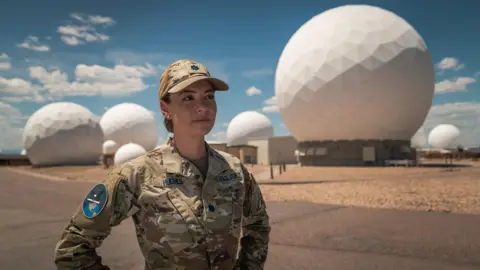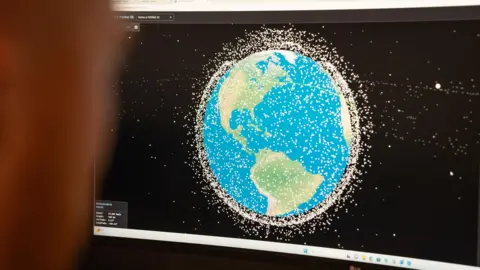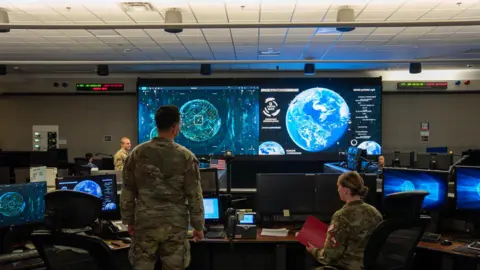Defence correspondent
There’s a short sharp shout: “Launch Yemen!” The men and women in uniform sitting in front of computers all respond in unison, “Copy, launch Yemen.”
In the US Space Force, they’re called Guardians, not troops. Staring into their screens at a base in the suburbs of Denver, Colorado, they’re able to track a missile launch from anywhere in the world – and follow it from its launch site to its likely point of impact.
We’re the first international journalists to be allowed inside the US Space Force’s missile warning and tracking operations room at Buckley Space Force base, a nerve centre where Guardians are on alert 24/7.
They’re surrounded by giant monitors which provide maps and data sent from a constellation of military satellites in space.
These Guardians are the first to detect the infra-red heat signature when a missile is launched. Moments later there’s another shout – “Launch Iran” – followed by a chorus of “Copy launch Iran.”
This time, it’s a drill. But last month they were doing it for real – when Iran fired a salvo of missiles towards the US military base at al-Udeid in Qatar, in response to US and Israeli strikes on Iran.
Colonel Ann Hughes describes the mood on that day as “heavy”. Unlike most launches, they’d been warned about that one in advance. They were able to track those Iranian missiles and then feed that information to the air defence batteries on the ground.
“Ultimately we saved the entire installation and the personnel that were there,” she says, expressing relief.
 BBC/Matthew Goddard
BBC/Matthew GoddardCol Hughes says they’ve been exceptionally busy in recent years, with wars raging in both the Middle East and Europe.
When I ask her whether they’ve been giving warnings to Ukraine, Col Hughes says: “We provide strategic and tactical missile warnings to all US and allied forces.” The US won’t publicly confirm it but it seems likely they might also have given Kyiv a heads up when it was about to come under Russian attack.
Buckley Space Force base will form a key part of President Donald Trump’s plans for a US missile defence shield, known as the Golden Dome.
He has earmarked $175bn (£130bn) for the ambitious programme – inspired by Israel’s Iron Dome air defence system. Many believe it will cost a lot more.
But the foundations are already in place at Buckley. Its skyline is dominated by massive radomes, round covers which protect powerful satellite dishes inside. They look like giant golf balls on the horizon. These satellite arrays have detected radio frequency waves from a supernova 11,000 light years away.
Lieutenant General David Miller, the commander of the US Space Operations Command, says the development of the Golden Dome, still in its early days, is a recognition of the increasing threats to the US homeland.
He specifically mentions China and Russia.
Both have developed hypersonic missiles which can travel at more than five times the speed of sound. Both have tested Fractional Orbital Bombardment Systems which are harder to track.
“The speed and physics associated with intercepting those requires the consideration of space-based interceptors,” General Miller says. He prefers to talk about “capabilities” to defend America’s interests, rather than weapons in space.
 BBC/Matthew Goddard
BBC/Matthew GoddardThe creation of the US Space Force five years ago is proof that space is now a warfighting domain. President Trump launched the force in his first term, describing space as “the world’s newest war-fighting domain”.
Both China and Russia have tested anti-satellite missiles, as well as ways of jamming their communications.
General Miller says Russia has “demonstrated the capability to potentially put a nuclear payload” in space. He says space is already an area “that is highly contested”, adding that “we also have to be prepared for conflict in space”.
Colonel Phoenix Hauser oversees the Space Forces Intelligence, Surveillance and Reconnaissance unit known as Delta 7. Their job is to find out what’s happening in space.
At their base near Colorado Spring, teams monitor screens showing thousands of small dots around the globe. There are already around 12,000 satellites in space. By the end of the decade that could grow to 60,000.
Col Hauser says their primary focus is on China. “It’s the pacing threat,” she says. China already has about a thousand satellites, half of them military ones. Over the next decade, Col Hauser says it will have tens of thousands more in low earth orbit. Space is increasingly congested and contested.
“We’re already sparring in space,” she says. “We see close unprofessional and unsafe engagements from our adversaries.” That includes satellites fitted with electronic jamming, lasers and even nets and grappling arms, which could be used to move another satellite off course.
Some have suggested there are already “dog fights” taking place in space.
“I don’t know that we’re quite there in the type of Top Gun like dog fighting perspective,” Col Hauser says. “But it’s something certainly that we need to be ready for.”
 BBC/Matthew Goddard
BBC/Matthew GoddardThe US Space Force is preparing for the possibility of conflict in space. Col Hauser says a year ago they “weren’t able to talk about having offensive space capabilities”. Now, she says their focus “is to generate options for the president so that we can gain and maintain space superiority through offensive and defensive space control”.
Gen Miller says the only way to prevent conflict is “through strength and we have to have our own capabilities in order to defend our assets”. He won’t give detail as to what that precisely means.
But the recent US strikes on Iran’s nuclear programme, Operation Midnight Hammer, gives a glimpse of what the US Space Force is already able to do. Those attacks by B-2 bombers also underline why continuing dominance in space remains crucial to the US military.
“You have to understand how much the United States military assumes the advantage that we derive from space,” Gen Miller says. That includes the ability to navigate and communicate over the horizon, and to deliver precision strikes using GPS.
The BBC has been given the first details about how US Space Force Guardians were involved in the operation.
“One of the things we did was leverage our electromagnetic warfare capability in order to ensure dominance throughout the operation”, Gen Miller says. The electro magnetic spectrum includes radio waves, microwaves, infra-red, and visible light.
“We knew the environment was going to be jammed,” he says. The US Space Force ensured that jamming was denied so that US B-2 bombers could arrive at their target and deliver their GPS guided Massive Ordnance Bombs with precision.
 BBC/Matthew Goddard
BBC/Matthew GoddardElectronic warfare specialists from US Space Force Delta 3 were already operating on the ground in the region.
Their Commander, Colonel Angelo Fernandez, shows me the rows of satellite dishes and command containers they can fly to locations anywhere in the world.
The dishes, he says, can be used to intercept and then drown out the communications of enemy forces, by “broadcasting noise that’s louder”.
“They were able to both protect US assets and at the same time open up a flight corridor,” he says.
Before, during and after the mission, US Space Force Guardians of Delta 7 were providing overwatch.
Colonel Phoenix Hauser says they were able to monitor the electro-magnetic spectrum “to understand does Iran know what’s happening, do they have any tactical warning the strikes might be happening”. They helped preserve the element of surprise and allowed the air crews to complete the mission undetected.
The US Space Force may be the youngest military service but it’s critical to America’s military might. Gen Miller says the entire US military “is dependent on space superiority”.
He wants to ensure that remains the case. And he has a warning for any adversary.
“When the US military gets focused on something – God help you!”
